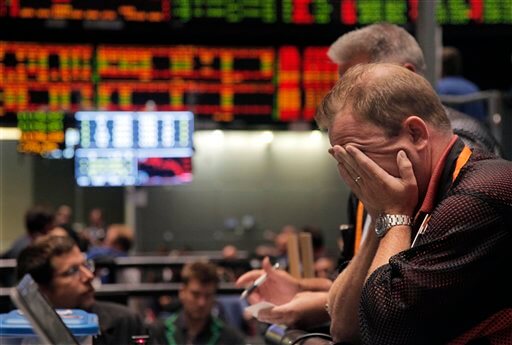
A plunging stock market and a stalled U.S. economy may force the Federal Reserve to use the dwindling number of tools it has left in an effort to boost growth and keep the country from sliding back into recession.
At the very least, the central bank is expected to acknowledge all the adverse things that have occurred since its policymaking committee last met in June.
But many private economists say they believe that the situation has grown so dark in recent days that Federal Reserve Chairman Ben Bernanke and his colleagues will be forced to do more.
On Monday, the Dow Jones industrial average suffered its sixth-worst point drop in history, falling 634.76 points. That decline came after credit rating agency Standard & Poor’s on Friday downgraded the United States’ long-term debt because of what it saw as political gridlock that is preventing Washington from making meaningful cuts in the country’s soaring budget deficits.
Adding to all the uncertainty, Europe is facing huge debt problems of its own. European officials are scrambling to prevent Italy and Spain from being consumed by a 21-month debt crisis that continues to roil global markets and has already forced Greece, Ireland and Portugal to seek large bailouts.
Bernanke and Treasury Secretary Timothy Geithner participated in an emergency conference call over the weekend with their colleagues from the Group of Seven rich industrial countries. The G-7 issued a statement pledging to take “all necessary measures to support financial stability and growth.”
Many economists say they believe Bernanke and his Fed colleagues should follow that pledge with concrete action when they hold their regular meeting Tuesday, given all the threats to the economy at present.
“I don’t think the Fed can stand by,” said Mark Zandi, chief economist at Moody’s Analytics. “This is a crisis of confidence and the Fed needs to shore up confidence.”
Many analysts expect the Fed to choose among a menu of options that Bernanke laid out in his mid-year testimony to Congress in July.
Among the options Bernanke discussed was providing a clear indication in the Fed’s statement about how long the central bank intends to keep interest rates at record lows. More explicit language on interest-rate policy might boost investors’ confidence at a dangerous moment for the global economy.
The central bank for more than two years has pledged to keep its target for the federal funds at “exceptionally low” levels for an “extended period” while never spelling out just how long “extended” might be. The funds rate has remained at zero to 0.25 percent for nearly three years.
In his congressional testimony, Bernanke said the Fed might also provide more clarity over the time period that it will keep its holdings of Treasury securities at record levels. By buying Treasury bonds, the Fed has sought to drive down long-term interest rates that govern such key activities as home purchases and business borrowing decisions.
On June 30, the Fed ended a $600 billion bond buying program, its second such effort, but it pledged to keep its holdings of those bonds constant until the economy started to improve.
Many investors would like to see the Fed launch a third round of bond buying. But the program has triggered a sharp debate inside the Fed about whether further bond purchases could set the stage for inflation down the road.
“There will be a high hurdle for considering a third round of bond buying,” said David Jones, chief economist at DMJ Advisors, a Denver economic consulting firm. “Fed officials who opposed the second round will argue that the Fed has done all it can to help the economy and anything more will risk higher inflation down the road.”
Bernanke this year made an historic change by scheduling news conferences after four of the Fed’s eight policy meetings each year, but the session Tuesday is not one of those.
In the weeks since Bernanke spoke to Congress in July, a batch of data has sketched a dimmer outlook for the economy. It grew at an annual rate of just 0.8 percent through the first six months of the year, the slowest stretch since the recovery began two years ago.
Bernanke in his July testimony said the Fed would consider more stimulus only if the economy weakened further and the threat of deflation returned, conditions that existed when he raised the prospects of the second round of bond buying a year ago.
Copyright 2011 The Associated Press.
































